
Wes Janz , author of the forthcoming book One Small Project , which will present itself in a gallery show this April, has been staying busy since we last caught up with him . Last winter, he visited several informal settlements and squatters in Buenos Aires. And last summer he scouted the Tijuana borderlands for an upcoming field study project he's planning for his Ball State students this February, where they will document the landscapes and architectures of the undocumenteds coming across the border into the U.S. In addition, his spring semester studio at the Virginia Ball Center for Creative Inquiry explores the homeless context in Indianapolis. The group will produce an installation at the Dean Johnson Gallery to depict their findings and host three discussions to bring some of their questions to a larger audience. In September, a number of his projects were featured in the “Shelter” show at the Contemporary Art Institute of Detroit , and Azure Magazine will be featuring Janz and his work in their May/2007 issue. Most recently, however, he has been touring the Rust Belt of the American Midwest, where local economies are evaporating and cities are literally shrinking overnight.
What follows is a field dispatch from what he and colleague Olon Dotson called the "Midwess Distress Tour." Together, the two vanned up a dozen or so students and drove furiously through the hollowed landscape of Detroit, Flint, Gary, Chicago, East St. Louis, and Cincinnati, to chart a depressing survey of an endless supply of demolished memories, places of eviction, architectures in abandonment, and the emotionally-charged back roads of antiquated America lingering on the chopping block of redevelopment. It is an eerily beautiful but sad glimpse of urban depression, the phenomena of decay, scrap futures, and the end of one run-on symbolic deconstructed home; it is the portrait of a hidden real-estate and recycling war zone that has become an undercurrent for much of America’s future city planning strategy.
-- Bryan Finoki
Compared to What?
Detroit, Flint, Gary, Chicago, East St. Louis, and Cincinnati, 2006 A.D.
by Wes Janz
“Sorry Bossman.”
I’m in an SUV in an abandoned lot at 3rd and Grand Traverse. Flint, Michigan. It’s concrete and asphalt, overgrown, untended (intended? unintended?) with a broken down telephone booth, liquor store, and gasoline station nearby.
Tim reaches in to shake hands with Mickel, passenger seat, and I flinch, involuntary, concerned about Mickel’s safety and digital camera. Tim jerks his hand out, involuntary. “Sorry Bossman,” as he steps back, “I’m a college student.” Then he asks about money for the bus, the telephone. I’d given fifty cents to a woman in the liquor store parking lot. Tim cut me off: “I don’t care about what you did for her. I need money Bossman.”
Fifteen seconds of Day Two of the Midwess Distress Tour. November 9-14, 2006. Olon Dotson (my faculty colleague and primary organizer of the road trip), five international graduate students (Marwa, Mickel, Nitya, Sweata, and Sujata), six of Olon’s 4th year architecture students, Emile, and me.
Distressed are big chunks of Detroit, Flint, Gary, Chicago, East St. Louis, and Cincinnati.
Depressed. Dysfunctioned.
Disoriented. Devolved.
Dissed. Dissing.
How many abandoned buildings should I photograph and take others to photograph, before I get the picture? Before we get the pictures ?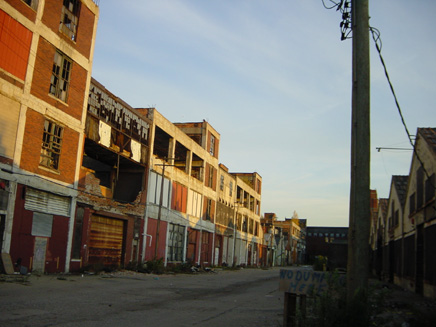
Detroit, Michigan, October 2006.
How many houses do you have to see being torn from a city’s fabric before the tearing of one life from another no longer registers?
When should you stop, or start , caring?
These people, buildings, and cities demand their moment and your attention. They have a voice, and when you are standing in their presence, you listen.
Detroit is scale. According to Jeff Byles’s book Rubble , 161,000 buildings were torn down between 1970 and 2000 (almost 1/2 of the city’s occupied housing stock); there were 15,215 empty buildings in the city in 1989; and 48 percent of the city’s population was lost (almost 900,000 persons) since the city’s population peak in 1950.
Like the other cities, Flint is shrinking. At its peak: 180,000 residents; 80,000 General Motors jobs (GM was founded in Flint one hundred years ago). Today: 120,000 people, 17,000 GM workers.
In Gary, civic monuments are abandoned, in ruin. It seems likely they will never be reinvigorated or torn down. Complete inaction and indecision is a kind of action and decision. Resolution.
The Chicago Housing Authority is tearing down, building, and even renaming housing projects because they (and we) are desperate to forget. “Monsters of the Midway,” circa 2006—“Come one, come all! While they’re still alive! See it for yourself! The worst housing ever built! The horrors of Cabrini-Green! The terrors of Ida B. Wells! The lost lives of Stateway Gardens! Step right up!!!”
East St. Louis, Illinois, October 2006.
East St. Louis is widespread vacancy and boarding, with ruins of houses long abandoned, but not hauled away, bounded by chain link fences. House piles.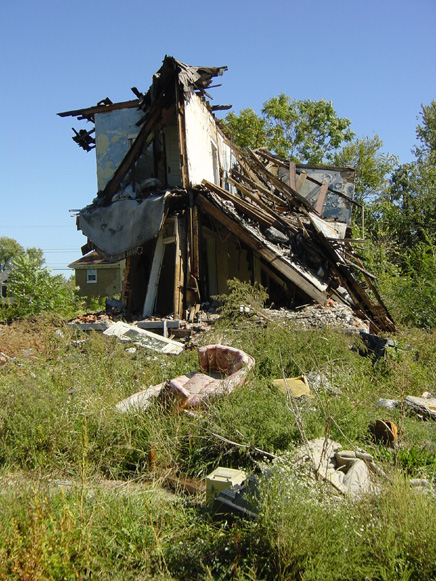
East St. Louis, Illinois, October 2006.
Over-the-Rhine in Cincinnati is recovering (again), this time from riots in 2001.
We’re designers, so it’s normal for us—this is how we’ve been trained—to think that we can make a difference in such places. That we can plan or build our way out of deep dilemmas, or design the solution once the problem is identified, or that there always will be an economic climate that will cause development to occur—live/work housing, commercial spaces connected to tourist/entertainment activities, open space planning, whatever. Our reliance on such beliefs or forces is so assumed that when they are gone the bottom drops out of any design profession. Out of my profession.
In the 1991 article “Can Architects be Socially Responsible? ” Margaret Crawford asked fundamental questions of the profession. Among her central arguments is Crawford’s answer to the article’s title:
Q: Can architects be socially responsible?
A: “[A]s the profession is presently constituted, no. Both the restricted practices and discourse of the profession have reduced the scope of architecture to two equally unpromising polarities: compromised practice or esoteric philosophies of inaction.”
Crawford offers two avenues for further exploration. One focuses on “existing material conditions rather than on idealistic projections of future technical capabilities”; the other seeks “compelling stories about social needs” such as the homeless, individuals excluded from the real estate market, communities threatened by decay or development, and elderly, poor, and minority groups with inadequate housing.
Crawford is not alone. Les McCann brings his own assessments:
I love the lie and lie the love
A-Hangin’ on, with push and shove
Possession is the motivation
That is hangin’ up the God-damn nation
Looks like we always end up in a rut (everybody now!)
Tryin’ to make it real. Compared to what? . . .
Where’s that bee and where’s that honey?
Where’s my God and where’s my money?
Unreal values, crass distortion
Unwed mothers need abortion
Kind of brings to mind ol’ young King Tut (He did it now)
Tried to make it real? Compared to what?
- “Compared to What?,” Les McCann
While I knew of Crawford’s arguments before the Distress Tour, McCann’s voice was new to me (and provided by Olon on a six CD soundtrack he put together for the field trip). “Compared to What?” expresses the man’s confusions and demands for another kind of progress, different sorts of questions, and other expressions of concern, compassion, and love for humanity and humans. This too, like Crawford, is a challenge framed by “existing material conditions” (possessions, ruts, unreal values, where’s my money?) and “compelling stories” (everybody now!, unwed mothers, King Tut) that must be engaged.
Detroit, Flint, Gary, Chicago, East St. Louis, and Cincinnati are worlds where most if not everything we know as architects is wrong, or useless. Everything we know, all architectural knowledge, becomes secondary, or disproved, or of little or no use. From almost any perspective—sociological, economic, political, and architectural—these are abnormal places that are now normal. There are problems so deep, lives so destroyed, neighborhoods so defunct, buildings so deteriorated, that one comes to understand that nothing can be done. Nothing. And this is normal.
Compared to what? Compared to nothing, except maybe each other.
Detroit is scale and process. Thousands and thousands of basements filled with crushed house. Buildings buried where they stood. In the glory years of the U.S. auto industry, imagine what was then—the energy of these neighborhoods, working class households, and proud people. Now, stealth houses and few people: there and gone. The city rots beneath our feet.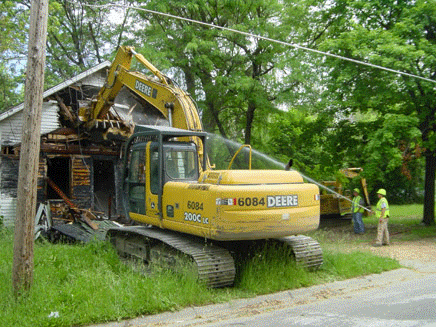
Flint, Michigan, June 2006.
According to Flint’s mayoral aide, between two to seven houses are torn down every day. Every block (and this is only a small exaggeration) has a boarded up building, probably a house that was poorly constructed post World War I or II. The house served its time, there’s nothing wrong with acknowledging it’s used up, long abandoned, its owners gone, probably to another city, job, and life. The thing left behind, boarded, waiting not for reuse, that’d be too elegant, too nice a story . . . just waiting . . . falling down, falling in . . . waiting . . . one winter season without heat causes gypsum board to peel . . . several years without roof repairs and the attic insulation gets too heavy and brings down the ceiling . . . untended gutters and downspouts let water erode earth around the foundations and they cave in . . . be patient . . . scrappers are watching, of course, they’re organized and smart (and desperate), and soon enough anything with any obvious recycling value is gone, aluminum siding is stripped off in broad daylight, copper pipes too (just for example) . . . waiting . . . for the City’s big backhoe to tear it down, smashing, chopping, snorting, the driver aggressive, in his element, and alive, chewing at it, eating the house, disgorging the vomit into a dumpster, ALIVE!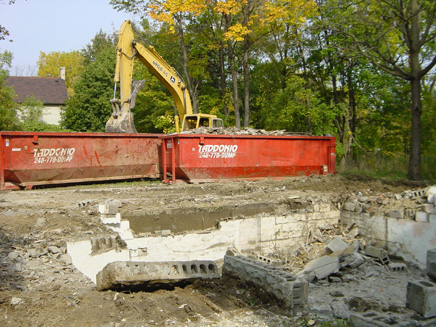
Flint, Michigan, October 2006.
Dead, the house is gone to the landfill: 200 cubic yards of waste/house x 5 houses torn down per day (plus/minus) x 5 work days/week x 52 weeks = 260,000 cubic yards per year. That’s equivalent to a standard city block in Manhattan covered with a 30-foot-tall chunk of detritus. Infrastructural shit. Every day, every week, every month, every year, probably for the rest of my life, maybe for the remainder of your life.
Backfill is delivered, grass seed sprinkled, and it’s like there never was a building. Ever.
Cue David Spade: Ba-bye.
And as Flint shrinks, the landfill explodes. (For some, this is not such a bad thing; Flint imports garbage from Canada, it’s a growth industry.)
Then, four hours southwest into Indiana, listening to the Distress soundtrack, thinking about Tim and “Bossman,” helped by The Spinners and Arrested Development:
Laugh everyone at the fool with his heart in his hand
He can't quite understand that he's less than a man
There's an ember of pride
Watch how he tries hard to hide that he's dyin' inside
Livin' just a little
Laughing just a little
Ain't easy
- “Living a Little, Laughing a Little,” The Spinners
I saw a man with no clothes, no money, no plate
Mister Wendal, that's his name
No one ever knew his name 'cause he's a no one
Never thought twice about spending on an old bum
Until I had the chance to really get to know one
Now that I know him, to give him money isn't charity
He gives me some knowledge, I buy him some shoes
And to think blacks spend all that money on big colleges
Still most of y'all come out confused
- “Mr. Wendal,” Arrested Development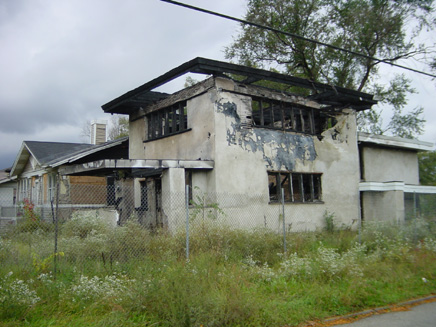
Gary, Indiana, October 2006.
Gary is Athens, or Pompeii, or Mayan ruins on the Yucatan Peninsula, or Anasazi ruin sites in Chaco Canyon (see Diamond’s Collapse ), Houses gone, abandoned houses standing (and falling, slowly), overgrowth everywhere—nature is winning, reeling in the buildings. Churches are abandoned, congregations gone; this is serious distress. To add insult and gravity, the Wynant House, as designed by Frank Lloyd Wright is (recently) burned out too, an old friend now charred and ringed with chain link. This is a house of some significance. According to the website of preservationist Christopher A. Meyers, this particular mid-sized two-story dwelling—built as part of the American System of Housing, a building venture of Wright and the Richards Company of Wisconsin—is the only known extant example of Model D101. We slide through a seam in the chain link, climb the broken stairs, pass through its collapsing and scarred façade, and stand among the charred fallen beams. The fireplace stack—Wright’s hearth—provides no warmth or comfort. In a 1957 interview, published in the 1994 book The Oral History of Modern Architecture , the interviewer John Peter said to Wright: “In your houses you’ve always featured natural elements, fireplaces and so forth.” Wright responded: “I love the fire. I love to see that element. I love to feel that I am using it, that I have access to it, or control of it.” Others, it seems, share Wright’s fascination.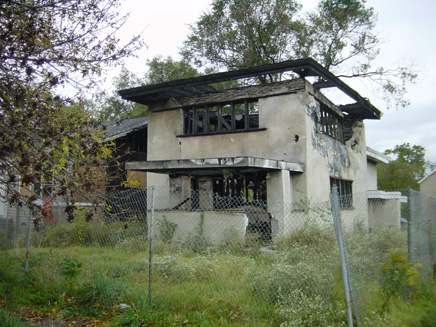
Gary, Indiana, October 2006.
Olon arranges for a night’s accommodations in a new urbanist development in Michigan City, Indiana. Marwa says it reminds her of Gary . . . sure, the architecture is new and the new urbanism is planned. But there are no people. It’s as abandoned as Gary. We have the place to ourselves. We have Lake Michigan to ourselves. We have ourselves.
Chicago, for us, is the CHA (Chicago Housing Authority), for better and worse. They give us a very nice tour of a number of their projects—so new they’re unoccupied. These CHA representatives are bright, engaged, positive, realistic. But my memory of Chicago, for better and worse, is of the last remaining tower of Stateway Gardens. Built in 1958, the Gardens originally accounted for 1,644 public housing units. The other seven towers are gone, already replaced with new housing. Now, in the last tower, there are ten apartments being occupied, and those people are to be out by the end of the month, ahead of the demolition. Olon and I go into the office to ask if we can take the students up. Two workers, both of whom are here to close down the project, treat us with complete disdain. Maybe “treat” is the wrong word as we were barely even acknowledged. We are sent by one to the other, then back, then back again, all the while one of the “workers” will not look away from her computer—she does not give us this dignity.
Olon says, “This is the CHA I know, the CHA everyone knew for decades.” The second set of elevators we try actually works, at least one of them does. Standing in the open lobby outside actually, we’re all waiting scared and anxious. In winter, the snow will blow into this lobby and ice will build up, what could people have been thinking? What I’m thinking is, The Spinners are right: living just a little ain’t easy. However, there’s almost no one here, all but ten families have moved on, there’s no crime, no danger really, but the place is thick, at least in our minds, with drug deals, stick-ups, hassles, attitudes, paybacks, street toughs. It’s heavy, weighing us down. We’re together, close, like we’re holding hands, waiting for an elevator.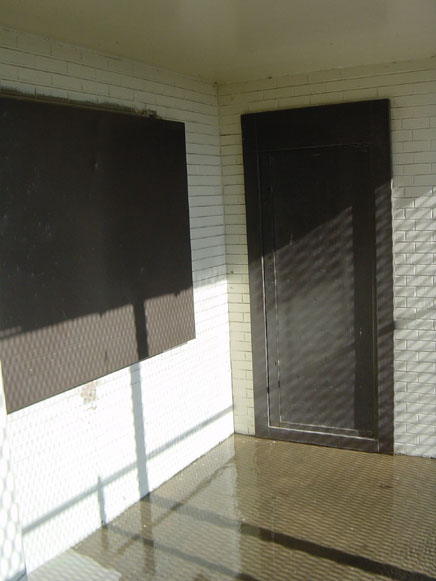 Chicago, Illinois, October 2006.
Chicago, Illinois, October 2006.
A few residents come in, wait, one strikes up a conversation with me while we wait for the elevator. He’s a brick mason, working locally. The elevator door opens, and the entire Midwess Distress crew crams in, me abruptly (and rudely) ending the nice conversation because I don’t want to be separated from the group. Probably the proper thought, but maybe not. The elevator will only go to the eighth floor, not fourteen. We step off, and the wind whips at us, hair is blowing all over the place, people grabbing jackets, zipping up, notebooks and sketchbooks flapping. Again, what were people thinking? Open corridors in towers in the Windy City? And this is a relatively warm early fall day and still the wind is biting at us, stabbing us. Winter? Get out, it must be a horror show, what were these designers, architects, planners, public officials thinking? (McCann again: how can this be real? Compared to what? The Arctic Circle?) I walk up and down some of the stairwells imagining broken light bulbs, drug deals, angry people (who wouldn’t be?). We walk around, get the picture (and pictures), take the elevator back downstairs, and the people are still waiting, the brick mason is there, still waiting.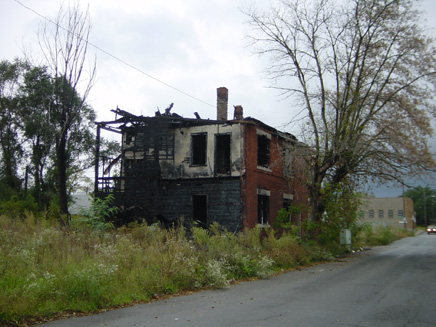
Gary, Indiana, October 2006.
Experiencing East St. Louis begins with a bus tour organized by the East St. Louis Action Research Project (ESLARP ) out of the University of Illinois Champaign-Urbana . Boarded up hotels, office buildings, apartment buildings. I ask Olon, “How many wig shops and beauticians and manicure and pedicure joints can one downtown support?” Houses. Houses in ruin. Fires set (drug-making, drug-taking, just burning to watch it burn, baby), roofs and ceilings falling, blackened walls down. You want to see a society falling? Even if you don’t, that’s what’s happened and is happening. Olon and I are attracted to the ruins of a large ornate Scottish Rite hall with a large pile of house across the street. While there, I walk past the hall down the street and see another house pile, this one surrounded by chain link. I take a few photos, and turn back to join the group. We’re in the vans and roll slowly past the length of the Scottish hall, turn the corner to eyeball the house pile which has my complete attention and suddenly there’s another massive house pile directly in front of us, on axis with us, at the end of the street. It’s a monster—a landfill site all by itself—but I don’t stop. Olon doesn’t stop. Maybe we even speed up. We’ve had it.
I’m quiet as we drive out of town. The students are quiet. I’m tired of analyzing, questioning, strategizing, designing. I’m playing music. It’s loud. There’s nothing to say that others haven’t said much better:
Hang ups, let downs
Bad breaks, set backs
Natural fact is
I can’t pay my taxes
Oh, make me wanna holler
And throw up both my hands
Yea, it make me wanna holler
And throw up both my hands
Crime is increasing
Trigger happy policing
Panic is spreading
God knows where we are heading
Oh, make me wanna holler
They don’t understand
- “Inner City Blues” (Make Me Wanna Holler), Marvin Gaye
I hope you hear inside my voice of sorrow,
And that it motivates you to make a better tomorrow.
This place is cruel, nowhere could be much colder.
If we don’t change, the world will soon be over.
Living just enough, stop giving just enough for the city!!!!
- “For the City,” Stevie Wonder
For the love of money
People will steal from their mother
For the love of money
People will rob their own brother
For the love of money
People can’t even walk the streets
Because they never know who in the world they’re gonna beat
For that mean, oh mean, mean green
Almighty Dollar!
- “For the Love of Money,” The O’Jays
Distressed? Yes. The fact is, there’s more. According to a study commissioned by the Mayor’s Office in 2004, my home city, Indianapolis, has over 8,000 abandoned houses. And as documented by Nancey Green Leigh and Lynn Patterson in their article “Deconstruction to Redevelop: A Sustainable Alternative to Mechanical Demolition,” as published in the Journal of the American Planning Association (Spring 2006), other industrial cities report large numbers of abandoned structures, too, including Baltimore (15,000), Detroit (10,000), and Kansas City (5,000). There’s nothing to compare this to, this reality of Detroit, Flint, Gary, Chicago, East St. Louis, and Cincinnati, except itself.
Turning away? No. We found several interesting “new” organizations.
The Detroit Center of the University of Michigan , where Craig Wilkins , a faculty member in the Taubman College of Architecture + Urban Planning, is director of the Center’s urban planning and architecture component.
In Flint, the Genesee County Land Bank is the first such entity in the country. The Land Bank—works to prevent tax foreclosure on area homes and encourages reinvestment in the more than 4000 residential, commercial, and industrial properties it has acquired through the tax foreclosure process since its inception in 2002—has demolished in excess of 600 blighted structures throughout the city. These commercial buildings and houses were abandoned in the past years, maybe one to five to ten to twenty years ago.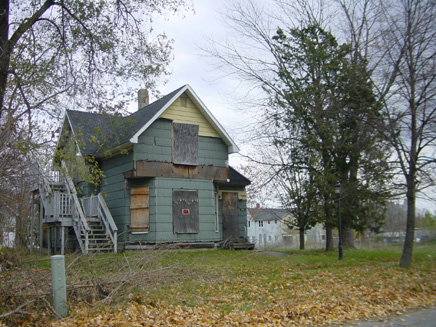
Flint, Michigan, November 2006.
“Emergency“ status is given to properties in danger of imminent collapse or which were recently set on fire. An “emergency“ house demolition takes one day, costs $6,000, and creates an average of 200 cubic yards of waste. With the exception of the basement foundation and slab—which are ground up for use in road construction—house remains are taken to nearby landfill sites. In the morning, a house exists. By late afternoon, the hole where it once settled is replaced by backfill, topsoil, and grass seed. The Land Bank works big and small. It mowed 2219 lots and removed 380 tons of debris in 2004, mowed 4082 lots and removed 270 tons of debris in 2005, sold 280 “side-lots“ to next-door neighbors of Land Bank properties for $1 each, completed 21 single-family re-habs, managed 57 rental properties, and granted a postponement of the foreclosure process to over 1350 homeowners allowing them to keep their homes. (For more, see Robert M. Beckley, “Flint Michigan and the Cowboy Economy: Deconstructing Flint. ”)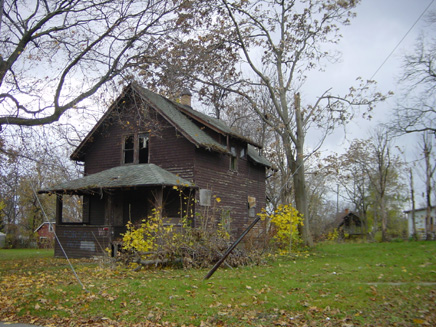
Flint, Michigan, November 2006.
Also in Flint, there’s the Good Beans Cafe, an urban outpost as coffee shop, committed to the historic neighborhood, surrounded by open land, abandoned houses, and other recently reconditioned houses. They’re making a difference, these small business owners.
The “new” Chicago Housing Authority. Maybe.
The East St. Louis Action Research Project (ESLARP ) establishes and maintains partnerships between community-based organizations in distressed urban areas with students, staff, and faculty at the university, in the attempt to revitalize the neighborhoods while advancing the university’s research, teaching, and service missions.
As part of a semester-long residential immersion program in Over-the-Rhine, Cincinnati offered by Miami University, students from Architecture and Interior Design, work on a design/build residential project when not in class; the other students engage in 15-20 hours/week of service learning with institutions addressing homelessness and affordable housing, and operating neighborhood centers and medical clinics.
In his book The Tipping Point , Malcolm Gladwell suggests that the best way to understand trends that mark our everyday life is to think of them as epidemics moving through a people, whether it be measles in a classroom, the popularity of a particular actress, or the region of the United States that attracts the most new residents. Three characteristics of epidemics form the foundation of his thinking: people, or places, get “infected” with “viruses”; little changes have big effects, and change often happens not gradually but at one dramatic moment. “Tipping point” is the “name given to the one dramatic moment in an epidemic when everything can change all at once.”
Gladwell explains the genesis of the term in ways linked directly to Midwest distress: “The expression [tipping point] first came into popular use in the 1970s to describe the flight to the suburbs of whites living in the older cities of the American Northeast. When the number of incoming African Americans in a particular neighborhood reached a certain point—20 percent, say—sociologists observed that the community would ‘tip’: most of the remaining whites would leave almost immediately.”
We—architects and educators of architects—are at our own tipping point. If the failed cities (and institutions and lives) of the Rust Belt show us anything it is that much of what planners, architects, and designers have done in the past has contributed to causing great harm to other human beings, that we have no clue how to be effective respondents in these settings, and that we have few ideas today, as Crawford argued fifteen years ago, regarding social responsibility.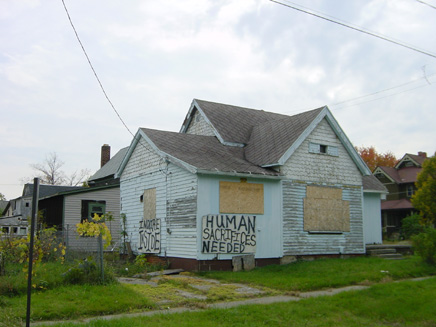
Flint, Michigan, October 2006.
It might be time to construct what Frank Rich has termed “a language of irony,” one that can convey trauma, waste, and distress in ways that lead to additional thinking, talking, knowledge creation, and in time, action.
It might be time, as McCann challenges, to ask for “rhyme or reason” and to voice doubts, even though others will “call it treason.”
And it might be time, as Gladwell suggests, to consider how “little things can make a big difference.”
In my experiences, working with U.S.-based students on studio projects based in some of the poorest neighborhoods in Delhi and Mumbai, reviewing the work of local architecture students in Buenos Aires trying to develop portable architectures for the city’s most disadvantaged populations, building post-tsunami permanent houses in Sri Lanka, and conducting a number of related design projects in classes at Ball State (including the design of a dignified rubbish bin, dwellings made only of recycled or reused building materials, and the smallest of plans and designs in the Historic River District of Flint, among others), it is extremely difficult to transfer knowledge gained regarding real, challenged lives into meaningful design initiatives. There is a kind of fall-away from what was learned about the disadvantaged or disenfranchised person and the existing material conditions of his, her, or their life, and a fall-back to known problems and solutions, to conventional thinking and ideas, to what was taught instead of what was learned.
This is, in many ways, understandable. We have little or nothing to compare with. We know little of lives that are simultaneously extraordinary and commonplace. We have few or no precedents to consider.
We have little reason to be concerned about forgotten lives; no interest in using the spaces in the city that have been long abandoned, and no reason to repurpose building elements or materials that can be found among the broken down architectures of our cities. We often don’t recognize poor people when we see them and we can usually live lives separate from theirs if we want to; we have plenty of space in this country, and we are confident that more new materials are always at the ready. Chicago, Illinois, October 2006.
Chicago, Illinois, October 2006.
For the sake of many persons, in many places, this can no longer be the case. Millions of people in the U.S., and approximately one billion people worldwide live in desperate conditions, have little or no money, and if they do build, they do so with whatever they can find. That our profession and professional schools have long denied or ignored the distress of these lives is a tragedy; that we are coming to our senses is among the most exciting of transformations. This is a building epidemic, a tipping point in which we must become even more engaged.
Detroit, Flint, Gary, Chicago, East St. Louis, and Cincinnati are our “canaries in the coal mine.” Their slow deaths mirror those of the profession and professional education, as currently conceived, mandated, and practiced. At the same time, the new organizations and individual human actions, one person to another, provide a sense that good work is being done, that some of the wounds are healing, and that architecture and architects might have a role constructing knowledge alongside others, and being engaged on the terms of others working as effective respondents to realities on the ground and in local lives.
On an earlier trip to Flint, Marwa, Mickel, Nitya, Sweata, Sujata, and I went along as Keith Austin, a squatter, was evicted from the front porch of an abandoned house where he had lived for three days. Neighbors were complaining to the Genesee County Land Bank (the owners of the property), knowing it was more likely that the Land Bank would respond than the local police department. We talked with Austin. He’s been squatting for three years, says he knows where to get food and water. In Austin’s own words, he knows “how to hunt.” Sujata said, “Perhaps this is like living in the wild.”
As we left, Austin said to us: “You can get as much as you want out of life. I believe in being positive.”
Imagine.
Creative Commons License
This work is licensed under a Creative Commons License .
/Creative Commons License
10 Comments
thank you.
Yes, thank you. This is very powerful and working towards radical - looking for the root if the issues.
who are these people using my bossman?
great story. beautifully written/observed. thanks to all involved.
architecture is so small comparing to realities like this.
entire curriculums might need overhauling for the realities. most of the so called futuristic concepts in archi-establishments' part is way overrated.
interestingly enough, part of flint's current mayor's (williamson) campaign was essentially knocking down old houses and abandon buildings. as much as people can speak of the tragedies of this, they are far too dangerous to remain in place. they attract meth labs and so on, not to mention their failed structural integrity. it is unfortunate that the urban populations have become so depleted in certain areas that knocking down houses is in fact desirable. however this is not a region-wide phenomenon. flint is a classic example of one city becoming too highly dependant on one industry, in fact one company.
more darkness on the horizon
The Shrinking American Automakers NYT
more in spiegel
great journey, great words.
if as architects we can only respond to social trends, why not go with the flow? or rather, improve the flow...
What is an architecture of planned obsolescence, where abandonment and decay are naturally built into the material fabric of the housing stock? Not disposable architecture, but recyclable architecture. We build with the intention that a neighborhood must be renewed say every 10 years. Land is not owned, it is borrowed. Housing stock migrates with the social amenities: families, jobs, schools.
Is it not a most basic human condition, an ecological condition, that an ecosystem will degrade and return its resources to begin something new? It is up to architects and planners to facilitate this process, at least for the built environment side of the equation. It is, of course, a greater responsibility for society to help the people remain sheltered, employed, and productive members of our society.
very lyrical - and I don't mean the songs/poems sprinkled through out!
is the future of the rust belt, the future of america? or are we creating an empty quarter in the middle of our land?
@ Nick Sowers. That was a heady way of saying we are doing a very lousy job as architects.
Let me further report that the housing issue is much worse than simple planned obsolescence.
The entire economy of means is woefully askew, and every 'under insulated' structure built since WWII inherently reflects a culture of snobbery and a flat-out race war.
AIA's think you know the rust belt, or Chicago, or even 1/164th of the structures that Frank Lloyd Wright observed as he traversed the country while his wife did the driving? I doubt you would know a passive solar structure if it were built directly across the street from your mother's home.
Back to Detroit, and the heavenly premise (read promise) of "plowing the city to save it!"...
No wait, let's take the 9th Ward. Let me assert that some of you AIA's actually believe that Brad Pitt's campaign truly attempts to "make it right."
I certainly do hope this team can recruit several photographers that are truly ready to tackle the ghetto and report on the 'built environment!' My 'technique' involved using a tripod as a potential battering ram, and black cape to scare the heck out of the local thugs. Another trick we used at Detroit's Central Station was to light up a flare, while using a megaphone to give the indication we were directing others to do things within the empty building. On say, Easter Sunday morning, one may never see the South Side appear so joyous and reverend!
Yet, treating life itself as a benign joke, our cityscapes as one extended school playground, gets boring. Eventually, you need to accept responsibility and understand that the rest of humanity will never overcome the mendacity of these basic premises. There are dozens of other ways.
Block this user
Are you sure you want to block this user and hide all related comments throughout the site?
Archinect
This is your first comment on Archinect. Your comment will be visible once approved.